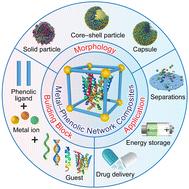当前位置:
X-MOL 学术
›
Chem. Soc. Rev.
›
论文详情
Our official English website, www.x-mol.net, welcomes your
feedback! (Note: you will need to create a separate account there.)
Metal–phenolic network composites: from fundamentals to applications
Chemical Society Reviews ( IF 40.4 ) Pub Date : 2024-10-04 , DOI: 10.1039/d3cs00273j Zhixing Lin, Hai Liu, Joseph J. Richardson, Wanjun Xu, Jingqu Chen, Jiajing Zhou, Frank Caruso
Chemical Society Reviews ( IF 40.4 ) Pub Date : 2024-10-04 , DOI: 10.1039/d3cs00273j Zhixing Lin, Hai Liu, Joseph J. Richardson, Wanjun Xu, Jingqu Chen, Jiajing Zhou, Frank Caruso

|
Composites with tailored compositions and functions have attracted widespread scientific and industrial interest. Metal–phenolic networks (MPNs), which are composed of phenolic ligands and metal ions, are amorphous adhesive coordination polymers that have been combined with various functional components to create composites with potential in chemistry, biology, and materials science. This review aims to provide a comprehensive summary of both fundamental knowledge and advancements in the field of MPN composites. The advantages of amorphous MPNs, over crystalline metal–organic frameworks, for fabricating composites are highlighted, including their mild synthesis, diverse interactions, and numerous intrinsic functionalities. The formation mechanisms and state-of-the-art synthesis strategies of MPN composites are summarized to guide their rational design. Subsequently, a detailed overview of the chemical interactions and structure–property relationships of composites based on different functional components (e.g., small molecules, polymers, biomacromolecules) is provided. Finally, perspectives are offered on the current challenges and future directions of MPN composites. This tutorial review is expected to serve as a fundamental guide for researchers in the field of metal–organic materials and to provide insights and avenues to enhance the performance of existing functional materials in applications across diverse fields.
中文翻译:

金属-酚醛网状复合材料:从基础到应用
具有定制成分和功能的复合材料引起了广泛的科学和工业兴趣。金属-酚醛网络 (MPN) 由酚醛配体和金属离子组成,是无定形胶粘剂配位聚合物,已与各种功能成分结合,创造出在化学、生物学和材料科学领域具有潜力的复合材料。本文旨在全面总结 MPN 复合材料领域的基础知识和进展。强调了无定形 MPN 相对于结晶金属有机框架在制造复合材料方面的优势,包括其温和的合成、多样化的相互作用和众多的固有功能。总结了 MPN 复合材料的形成机制和最先进的合成策略,以指导其合理设计。随后,详细概述了基于不同功能成分(例如,小分子、聚合物、生物大分子)的复合材料的化学相互作用和结构-性能关系。最后,对 MPN 复合材料的当前挑战和未来方向提出了展望。本教程综述有望成为金属有机材料领域研究人员的基本指南,并提供见解和途径,以提高现有功能材料在不同领域的应用中的性能。
更新日期:2024-10-04
中文翻译:

金属-酚醛网状复合材料:从基础到应用
具有定制成分和功能的复合材料引起了广泛的科学和工业兴趣。金属-酚醛网络 (MPN) 由酚醛配体和金属离子组成,是无定形胶粘剂配位聚合物,已与各种功能成分结合,创造出在化学、生物学和材料科学领域具有潜力的复合材料。本文旨在全面总结 MPN 复合材料领域的基础知识和进展。强调了无定形 MPN 相对于结晶金属有机框架在制造复合材料方面的优势,包括其温和的合成、多样化的相互作用和众多的固有功能。总结了 MPN 复合材料的形成机制和最先进的合成策略,以指导其合理设计。随后,详细概述了基于不同功能成分(例如,小分子、聚合物、生物大分子)的复合材料的化学相互作用和结构-性能关系。最后,对 MPN 复合材料的当前挑战和未来方向提出了展望。本教程综述有望成为金属有机材料领域研究人员的基本指南,并提供见解和途径,以提高现有功能材料在不同领域的应用中的性能。


















































 京公网安备 11010802027423号
京公网安备 11010802027423号